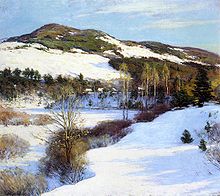Willard Leroy Metcalf
Willard Leroy Metcalf (born July 1, 1858 in Lowell , Massachusetts , † March 9, 1925 in New York City ) was an American painter.
Life
Metcalf spent the first years of his life on a farm in Maine . He began his artistic training with a wood cutter in Boston . The landscape painter George Loring Brown was then his teacher while he attended the Lowell Institute. Together with Brown he spent the summer months in the White Mountains of New Hampshire , where the first landscape studies were made. Later he was one of the first scholarship recipients of the School of the Museum of Fine Arts in Boston .
Due to his interest in ornithology and his drawing skills, he took part in an expedition to the southwestern United States in 1881. In New Mexico and Arizona he made numerous illustrations for the magazines Harpers and Century , with his documentation of the Indian tribe of the Zuñi receiving special recognition.
Due to the financial success of his illustrations, Metcalf was able to travel to France in 1883. In Paris he attended the Académie Julian , where he took lessons from Gustave Boulanger and Jules-Joseph Lefebvre . Metcalf studied all the major art movements in France in the 19th century. In addition to academic painting and the Barbizon School , he also learned about Impressionism and visited Pont-Aven and Giverny . Together with Theodore Robinson , he founded an American artist colony here in close proximity to Claude Monet .
During a study trip to Tunis and Morocco in 1887, Metcalf painted typical street scenes. The following year his painting Arabian Market was honored with an honorable mention in the Paris Salon .
In 1888 Metcalf returned to Boston, where he received critical acclaim at a solo exhibition of his work at the St. Botolph Club. In 1891 he moved to New York. During this time, Metcalf made a living doing illustrations, painting lessons, and selling some portraits. The longed-for success with his landscape paintings did not come until 1896. With the painting Gloucester Harbor , he won the prestigious Webb Prize at the annual exhibition of the Society of American Artists.
In 1897 he left the Society of American Artists and founded the artist community Ten American Painters , for which he also designed the manifesto. In 1899, he was commissioned to paint two murals to design the appeals court in New York.
Metcalf spent 1904 in Maine and again turned his painting to Impressionism. He himself described this as his personal " renaissance ". Although he had his studio in New York, he mostly painted in New England . From 1905 he is a regular in Old Lyme , Connecticut and part of the local artist colony. In 1908 he was elected to the American Academy of Arts and Letters .
Royal Cortissoz, the critic of the New York Daily Tribune, was one of Metcalf's major supporters. He repeatedly published monographic articles on the painter. From 1906 Metcalf had great success with his landscape paintings with the public. His favorite subjects were the landscapes of the Berkshires , Cornish (New Hampshire) , Springfield (Vermont) , Casco Bay and the Damariscotta Peninsula in Maine.
Works
literature
- American impressionism . Exhibition catalog for an exhibition in Berlin and Vienna. Smithsonian Institution Traveling Exhibition Service, Washington DC 1982
- William H. Gerdts: American Impressionism. Masterpieces from public and private collections in the United States of America . Exhibition catalog (Villa Favorita, Thyssen-Bornemisza Foundation, Lugano-Castagnola). Eidolon, Einsiedeln 1990
Web links
- Works by Willard Leroy Metcalf at Zeno.org .
Individual evidence
- ^ Members: Willard Leroy Metcalf. American Academy of Arts and Letters, accessed April 15, 2019 .
| personal data | |
|---|---|
| SURNAME | Metcalf, Willard Leroy |
| ALTERNATIVE NAMES | Hassam, Willard |
| BRIEF DESCRIPTION | American painter |
| DATE OF BIRTH | July 1, 1858 |
| PLACE OF BIRTH | Lowell , Massachusetts |
| DATE OF DEATH | March 9, 1925 |
| Place of death | New York City |








